The Key To Sustainable And Profitable Broiler Housing
If you are a farmer or rancher who raises broilers and wants to live a sustainable, healthy lifestyle, you have a problem:
It appears as though you need to choose between a high-efficiency system or a healthy, humane system.
Which will you prioritize?
At The Mobile Chicken House, we’ve faced the same problem and asked ourselves the same question.
Today we’re sharing our solution to this dilemma so you can raise healthy broilers and make a profitable living.
Let’s get to it!
Types Of Broiler Housing
Traditionally, there have been two ways to house broiler chickens:
- Commercial (Intensive) Housing
- Backyard (Free Range) Housing
Let’s explore these two housing systems to understand how they operate.
Commercial (Intensive) Broiler Housing
As a general rule, raising broilers in large commercial houses is the most efficient way to grow chickens.
The houses are usually 40-50 feet wide and 400-600 feet long. Most often, a commercial chicken house contains about 20,000 birds.
Using these houses, it’s not difficult to manage every part of a broiler's life so they grow at optimal speed.
Environmentally controlled houses allow chicken farmers to regulate temperature, humidity, light, feed, and more for their birds. Add it all together, and commercial farmers are taking chickens from zero to eight pounds in a matter of six weeks.
Now that’s efficiency.
However, commercial chicken houses come with significant downsides as well.
First of all, the broilers are normally kept indoors for the majority of their lives (in some cases, the birds are given access to the outdoors through small openings or doors, but the outdoor space is small and rarely utilized by the birds.)
Why is this a problem?
- The birds don’t live in a natural environment. Beyond that, being contained indoors means that chickens don’t have access to healthy and organic food like bugs, seeds, and grass.
- Chickens that aren’t exposed to sunlight can be nutritionally deficient.
And while it’s true that “birds of a feather flock together,” chickens that are too crowded will show signs of stress and be less healthy than those that have more room.
The Council of Agricultural Science and Technology states that each bird needs at least half a square foot of growing space, but we’ve found that more space is much better.
Birds contained in too small of a space can’t perform natural behaviors like roosting, spreading their wings, scratching the ground for forage, and more. The result is a broiler that is not as healthy as it could be.

Disease among broilers also rises when the birds are crowded into an enclosed space for the entirety of their life.
Unfortunately, there’s more:
Broilers raised in commercial chicken houses can also be detrimental to human health.
Why?
The old saying, “You are what you eat,” is at least partially true.
And since commercial chicken houses are all about moving enormous batches of chickens through their doors in short amounts of time, farmers often use antibiotics and hormonal supplements to speed up the growth process and avoid disease.
Surprisingly little research has been done on the health effects of these hormones in humans, but there are definitely warning signs.
For example:
A growth hormone (rBGH) is commonly injected into cows to spur milk production. While rBGH has no discernible effect on humans, it has been found that milk from rBGH-treated cows contains up to 10 times more IGF (an insulin-like growth factor in humans) than other milk.
And higher blood levels of IGF have been associated with an increased risk of breast, prostate, and other cancers in humans.
Here’s the bottom line:
Commercial chicken houses are highly efficient and profitable. However, they aren't the most humane way to raise broilers, and they result in fewer healthy chickens and, as a result, fewer healthy humans.
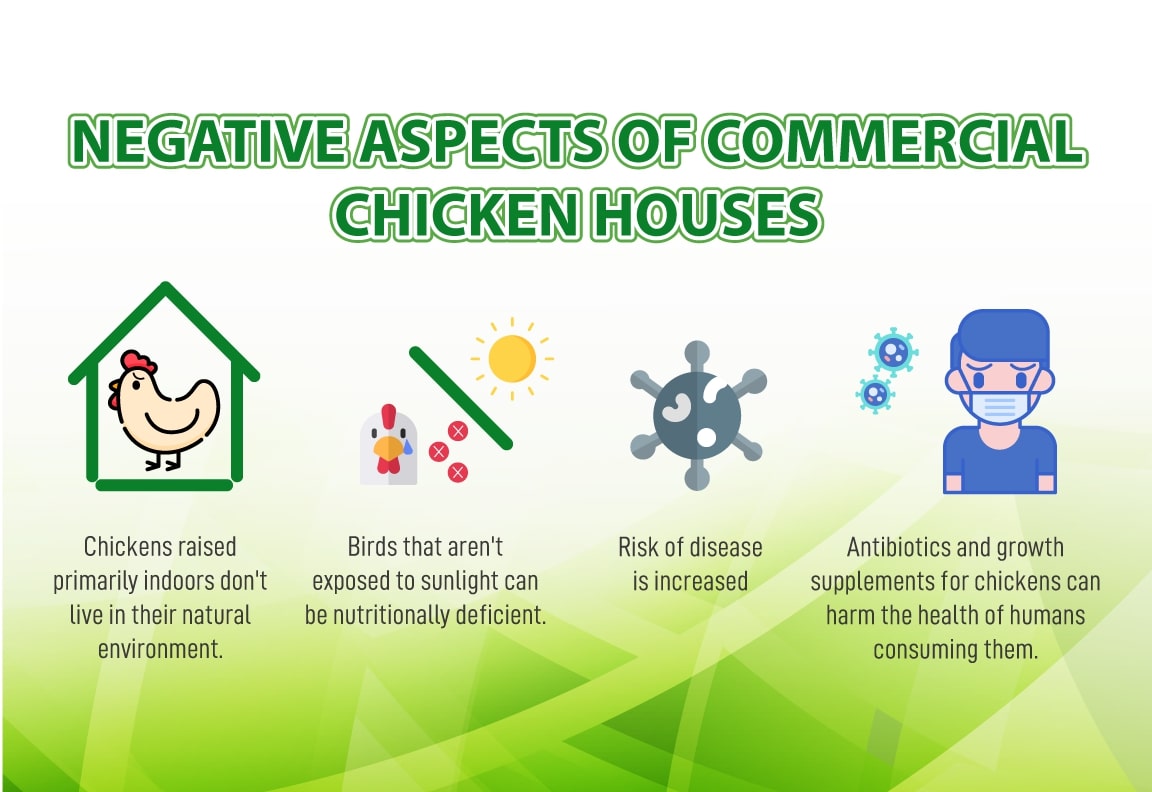
Backyard (Free Range) Broiler Housing
Many people that don't approve of using large commercial broiler houses revert to raising chickens and broilers with a backyard operation.
In many ways, it’s the ideal American dream:
You take some feed and water out to your chickens each day, and they spend their time running around the yard chasing bugs and other critters.
The birds are happy and healthy with plenty of sunshine, exercise, and goodies to eat in the yard. They might even come running when you call them. It's healthy for both the chickens' and the humans' mental health!
After a while, the chickens have matured, and it’s time for butchering day! You’ll have some good chicken meat for your freezer and maybe a little extra to give to friends and family.
However, if you are trying to run a profitable farm based on this system, you are in big trouble.
It takes way too much time and energy to care for hundreds or thousands of chickens this way.
Just imagine lugging sacks of feed and buckets of water out to thousands of chickens each day - or trying to keep an eye on them all! It’s not possible. You would lose hundreds of chickens to predators and you wouldn't be able to keep a good eye on all of them.
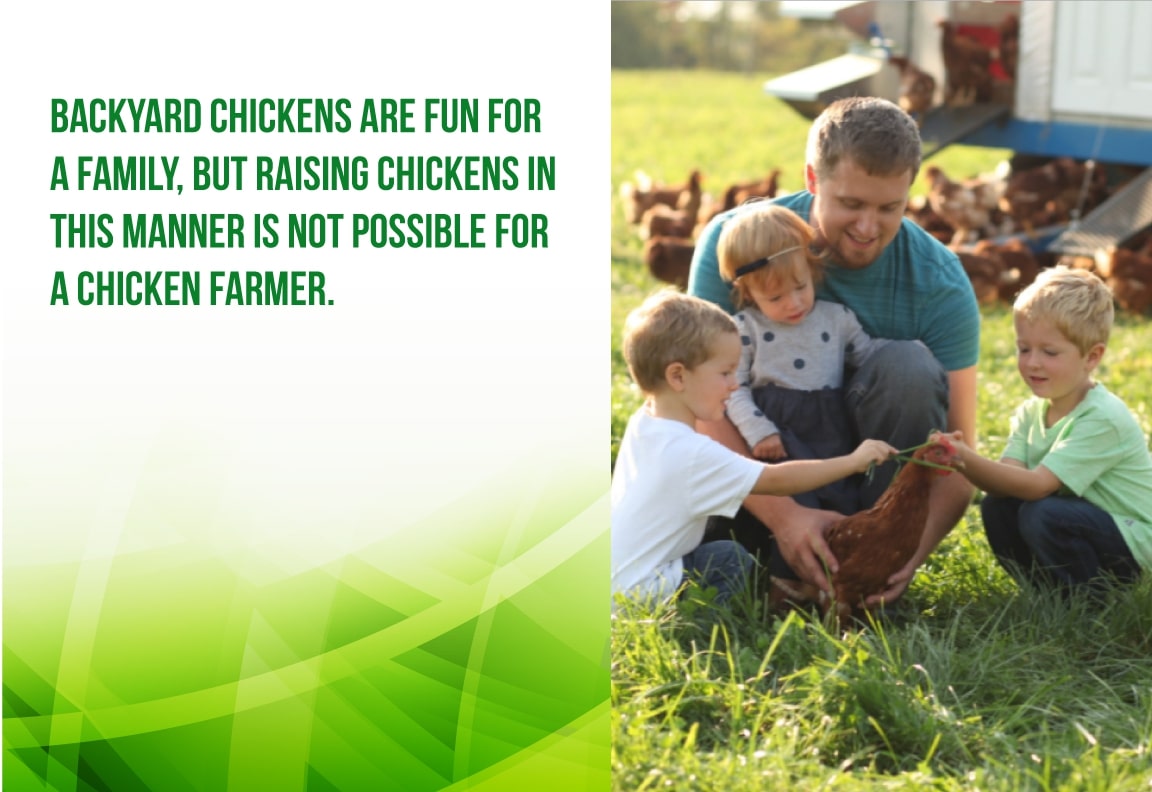
Beyond that, broilers that are allowed full free-range use up a lot of energy running around and don’t gain much weight.
In the end, you and your chickens will be healthy and happy, but you won’t be able to make any profit selling meat chickens.
The scales have tipped to the opposite side of commercial houses. Free-range broilers are healthy but very inefficient. It's a great way to raise chickens, but you aren't going to make a profit.
The Key To Great Broiler Housing
Here’s the dilemma:
Commercial chicken houses are highly productive but produce unhealthy broilers.
On the other hand, free-range broilers are healthy, but the system can’t make money for a full-time chicken farmer.

Thankfully, there’s a solution.
At The Mobile Chicken House, we have utilized a semi-intensive housing system. Essentially, we’ve combined the features of commercial chicken houses with a backyard chicken coop.
The result?
Efficiency paired with natural living.
We’ve created a mobile range coop for broilers that allows them to be outside, be in the sunshine, and forage for organic food.
We’ve also worked with other animal experts like Fertrell to hit the sweet spot in which chickens aren’t stressed by overcrowding and don’t burn off too many calories running around.
Since you need to be able to raise more than ten or so chickens at a time, the houses are designed to hold 250 broilers.
And to accommodate the schedules of busy farmers, we incorporated some features of commercial coops like automated feed and water lines.
You can finally raise healthy broilers and still make a profit!
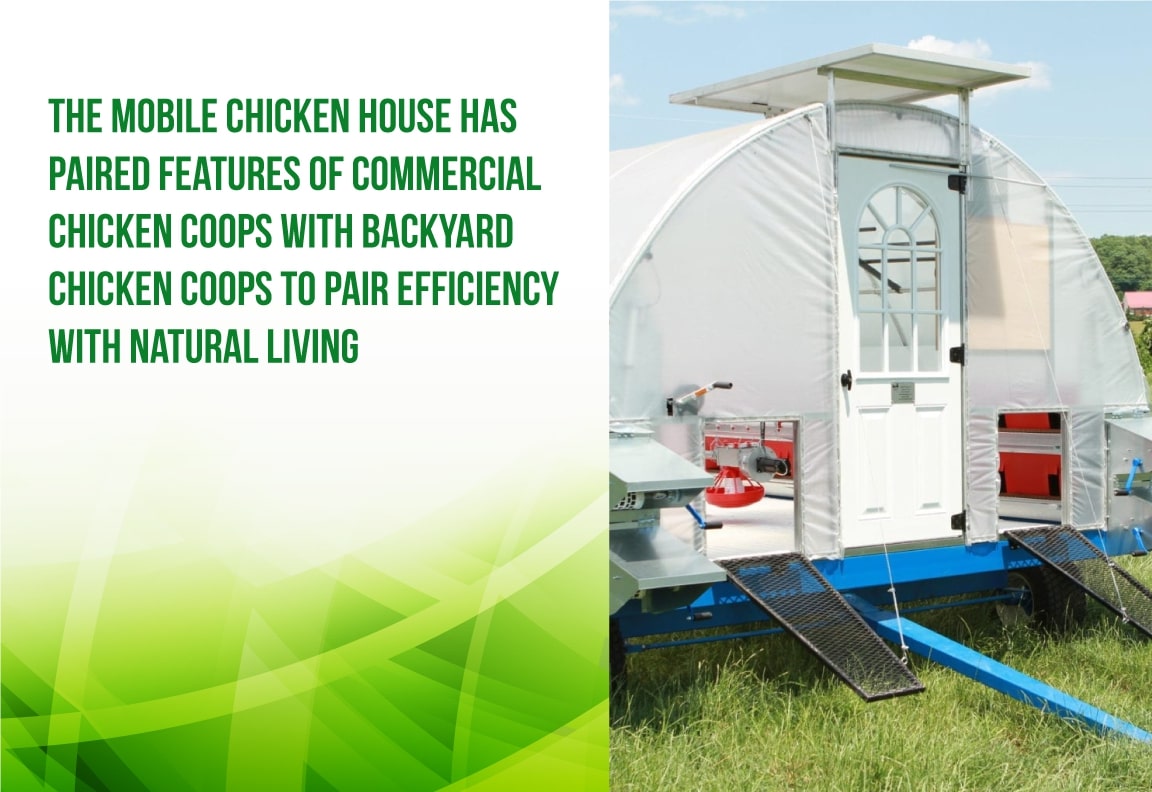
11 Features Your Broiler Housing Should Have
We’ve already discussed a few of the advantages of the mobile range coop developed by The Mobile Chicken House.
Now, let’s explore some other features of these mobile chicken coops!
PRO TIP: Whether or not you use a chicken coop from The Mobile Chicken House, these are features that should be included in any good broiler housing system.
Feature #1
Movable Coops
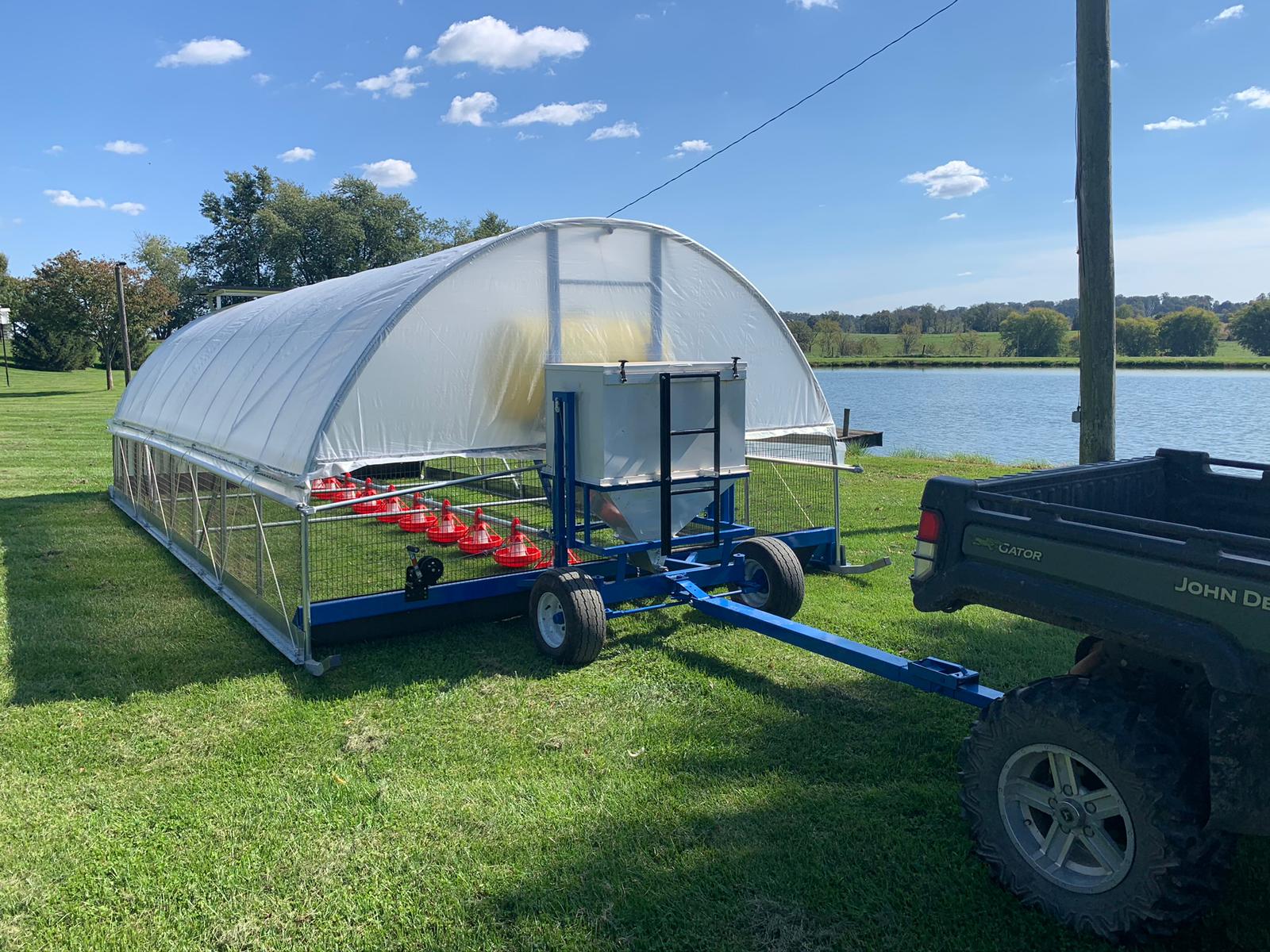
There are a few farmers that raise chickens on pasture, but there are fewer who raise their chickens on pasture PLUS move their coop around to fresh ground regularly.
Is it really a big deal if pasture-raised chickens are mobile?
Absolutely!
Here are just a few benefits of raising broiler chickens in a mobile chicken coop.
- The chickens have access to fresh organic matter to forage from the ground
- The ground doesn’t become too trampled or covered in droppings and can remain healthy
- A healthy number of insects remain in the soil
- It produces healthier soil and grass
And that’s just the beginning! For more information, read our blog on the advantages of mobile chicken coops.
Feature #2
Easy Access Door
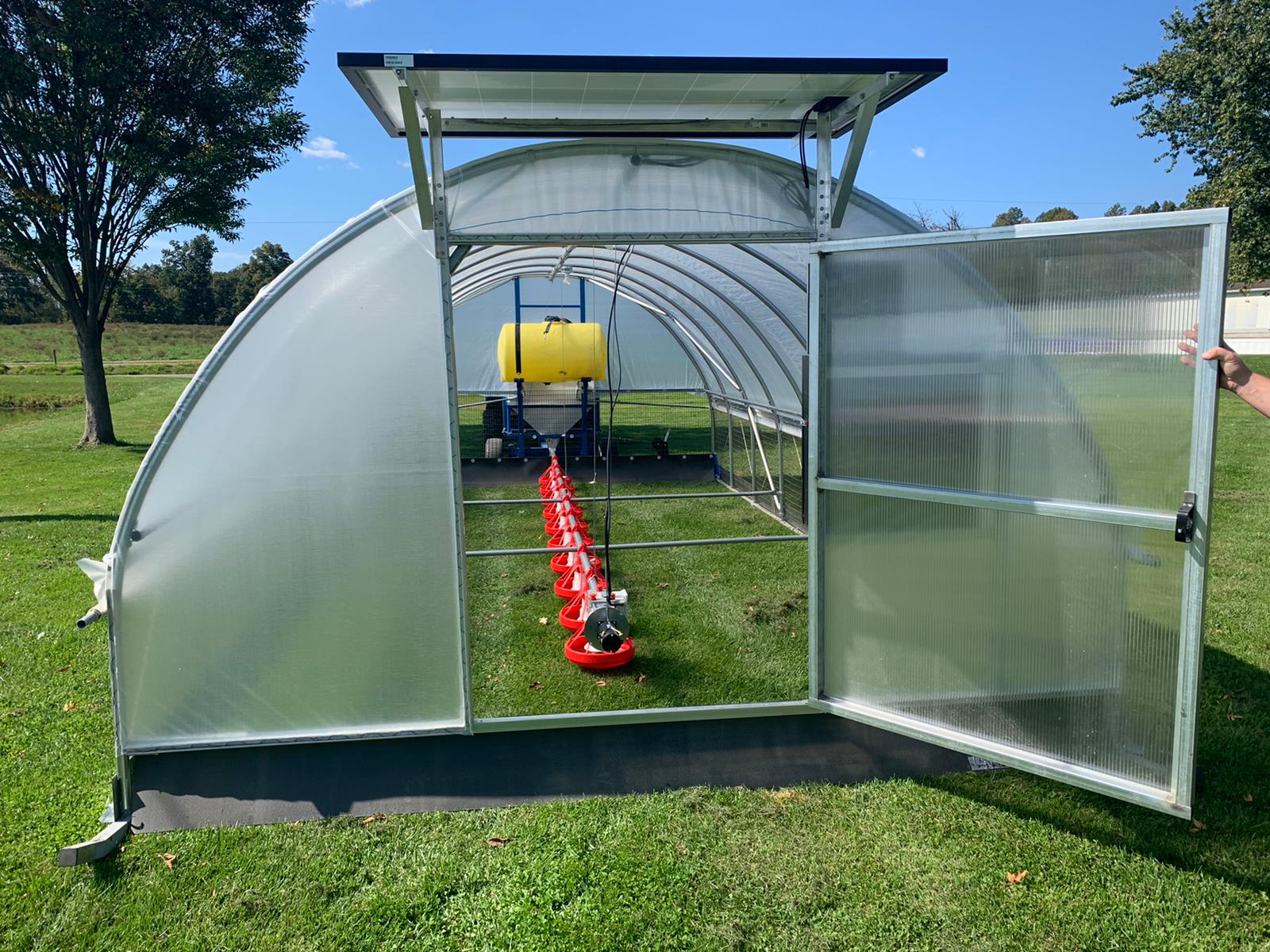
Easy access doors for a chicken house may seem elementary, but the details matter!
I mean, the chickens might be able to get in and out, but what about you? What about you when you are carrying a large crate of food or a sick chicken? You don't want to have to squeeze through a tiny door then!
Wide doors are especially important in broiler houses when you will be carrying large crates in and out of the chicken coop.
We’ve equipped our mobile range coop with a four-foot door for easy access, and we suggest you find a coop with a door at least that size.
Feature #3:
Automated Feed Lines
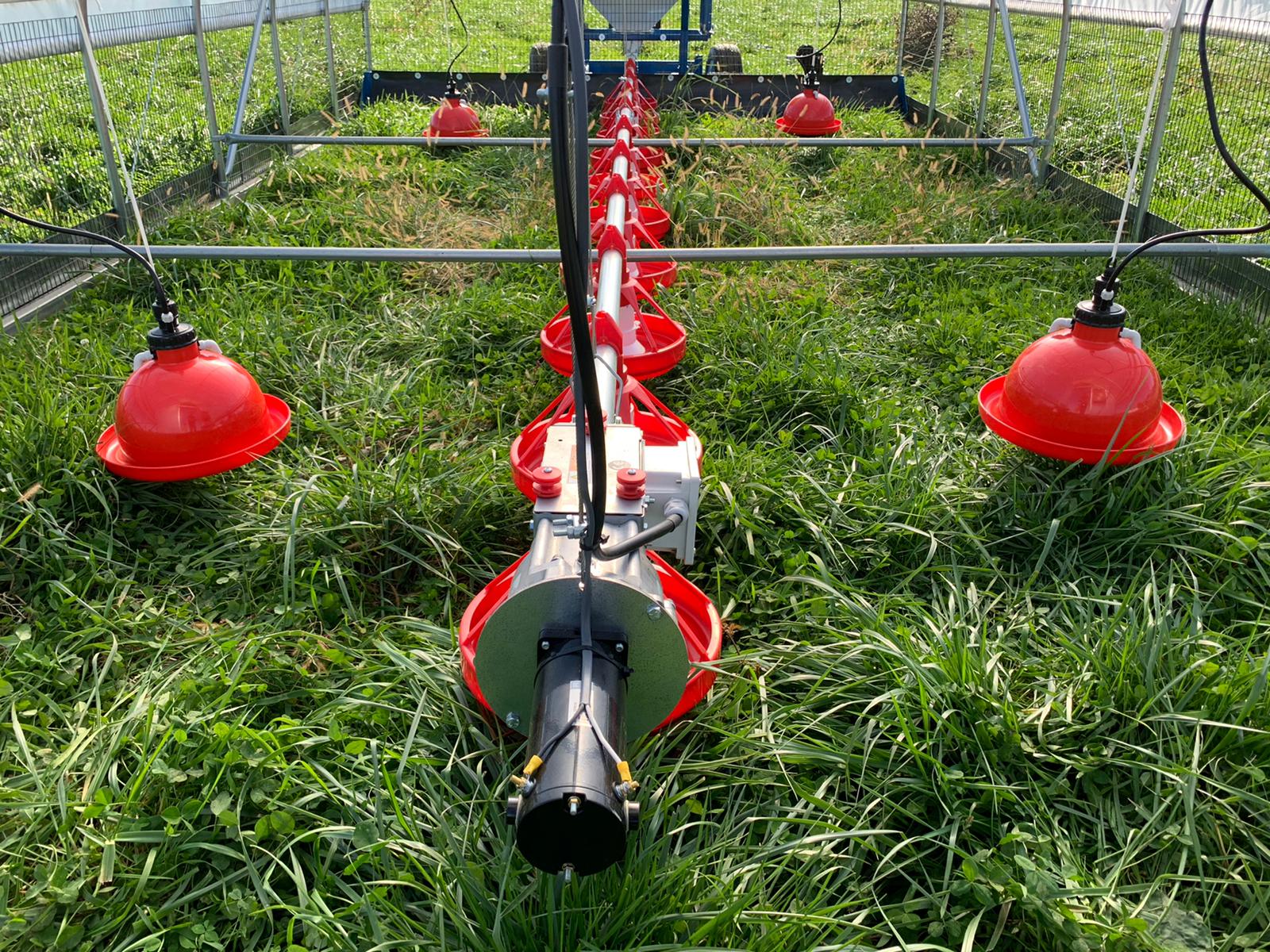
Treating any animal in an inhumane manner is a serious problem.
However, trying to grow meat chickens efficiently is perfectly ok - especially if you stay focused on quality-driven and sustainable growing methods.
That’s why we utilize automated feed lines in our broiler coops.
And it couldn’t be simpler:
- Load chicken feed in the 750-pound feed hopper
- Allow the power motor to deposit feed into individual feed trays automatically
- Watch the birds eat and grow!
There are more benefits to an automated feed line than might initially meet the eye.
First, automated feed lines save you as the farmer a lot of time and energy. Instead of feeding your chickens every day, you can fill the hopper every 3-4 days.
You can also put automatic feed lines on a timer so the birds can begin learning when it is time to eat. This also allows you to make sure just the right amount of feed is given to each bird.
And finally, the motors that distribute the feed make a bit of noise when running. While this might seem like a nuisance, it is actually a positive thing.
When the chickens hear the motor running, they know it is time to eat. This keeps the more with-it broilers from hogging all the food and ensures that all the birds will get enough to grow quickly! (If you want to know more about how you could train your chickens for a mobile chicken coop, read our ultimate guide to training your chickens for a mobile chicken house.)
And last but not least, it can help make so the birds waste less food. Chickens are notorious food-wasters and if they have unlimited access to feed they won't act responsibly with it!
Feature #4
Adjustable Feeders
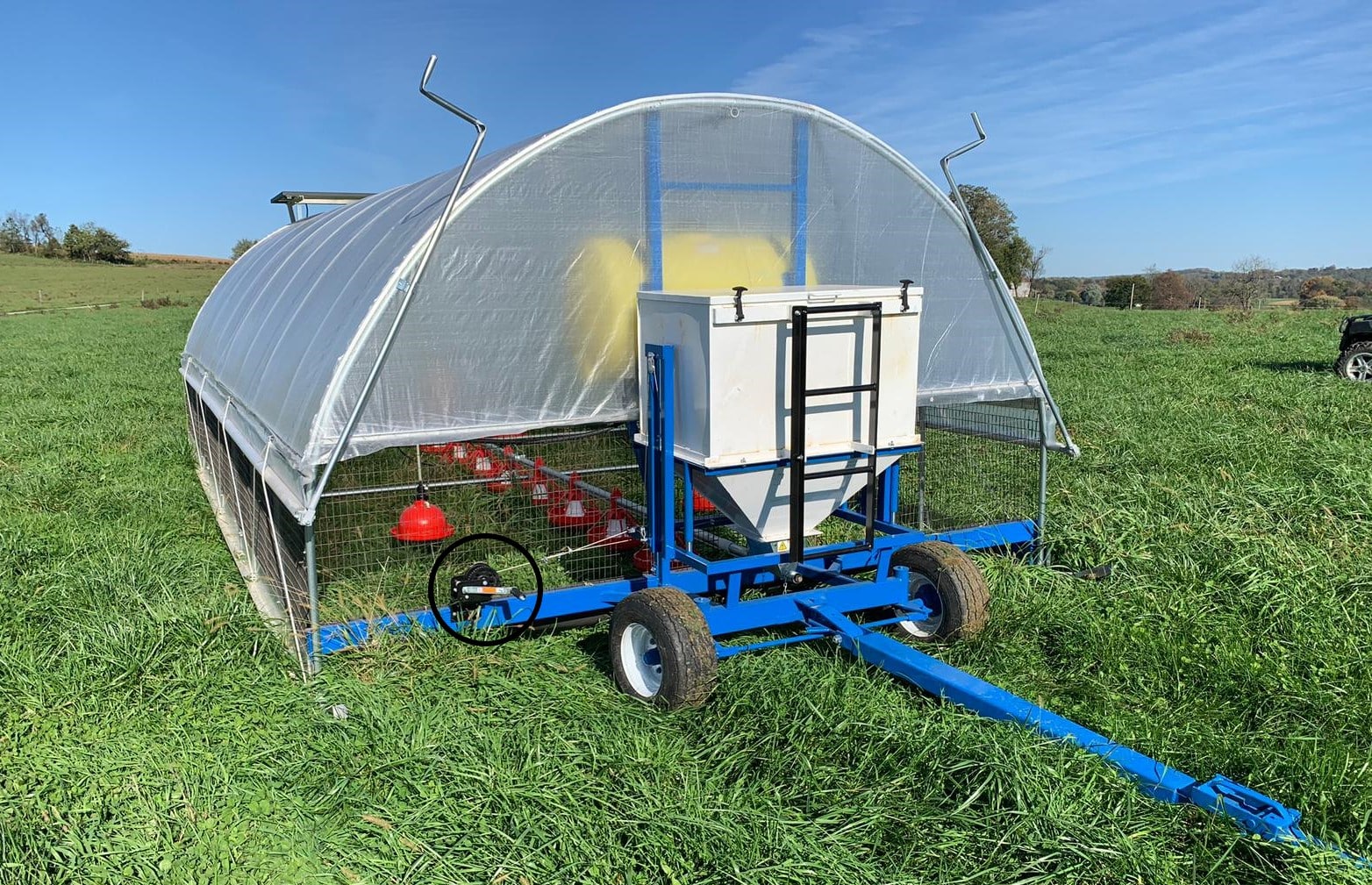
Many farmers know the frustration of having their chickens waste a lot of feed. In fact, a quick google search on “chickens wasting feed” brings up about 746,000 search results!
The problem is that birds often pick through their feed and throw plenty of it on the ground.
The result is wasted feed money and chicken with unbalanced diets.
Thankfully, there is a relatively easy solution to this problem.
If you make sure that your feeder’s height is even with the height of an average bird’s back, you can solve your problem. The chickens aren’t able to be so choosy and eat what’s given to them.
That’s why all the feeders in our mobile range coops can be adjusted simultaneously with the crank of a handle.
As the broilers grow, give the crank a few turns, and you can keep the feeders at the appropriate height! Problem solved.
Feature #5
Automated Lights
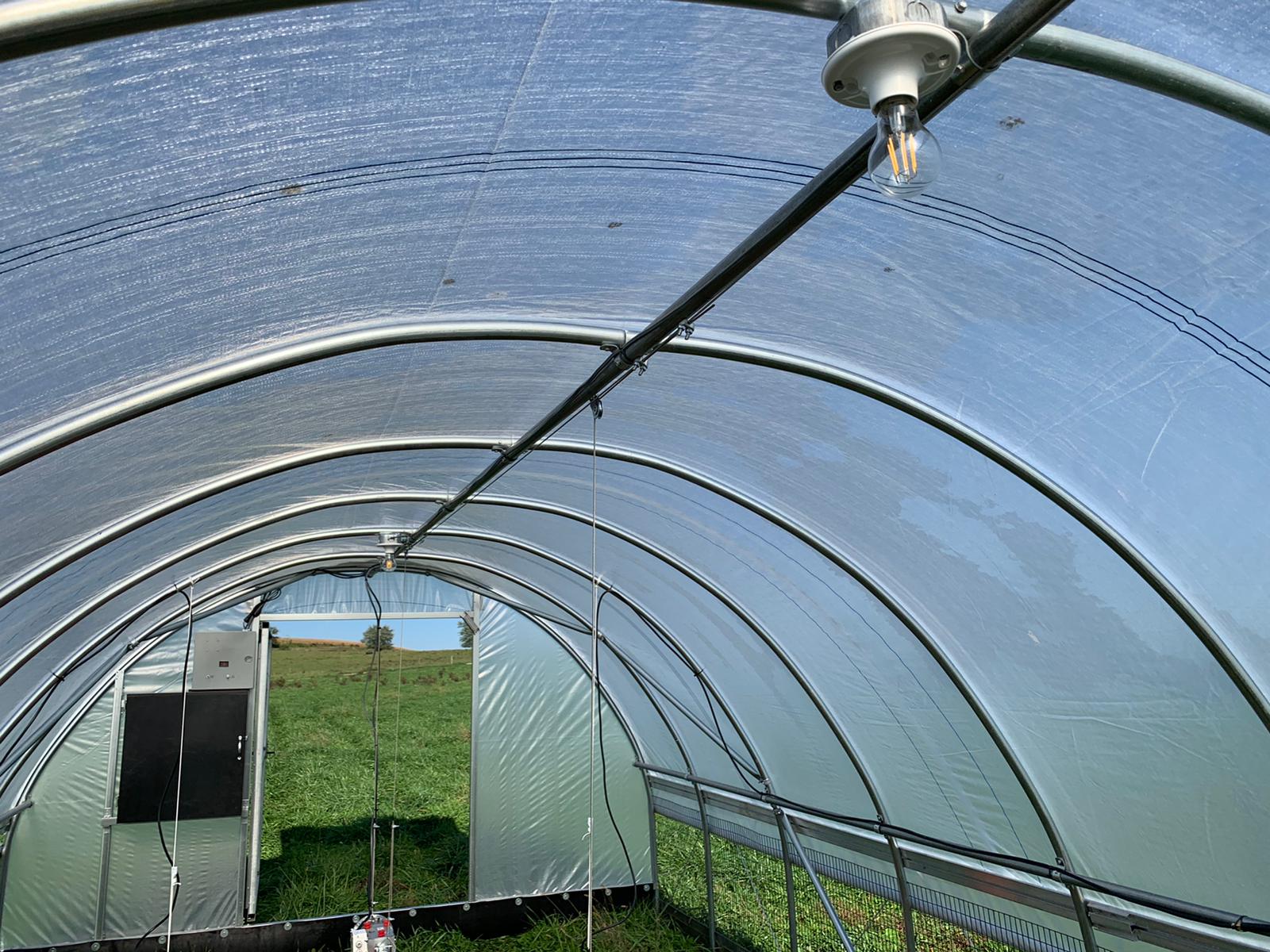
Lighting in poultry production is a big deal, as producers want to provide optimum conditions for the birds to reach their full genetic potential.
Factors such as light intensity, organization of light-dark cycles (the photoperiod), light source type, and the wavelength of light are all worth considering.
Our houses come equipped with automated lights so you can maximize the growth of your broilers.
Just decide on the lighting schedule you want, and set the system to meet your needs!
Feature #6
Push and Pull Hitch Hook-up
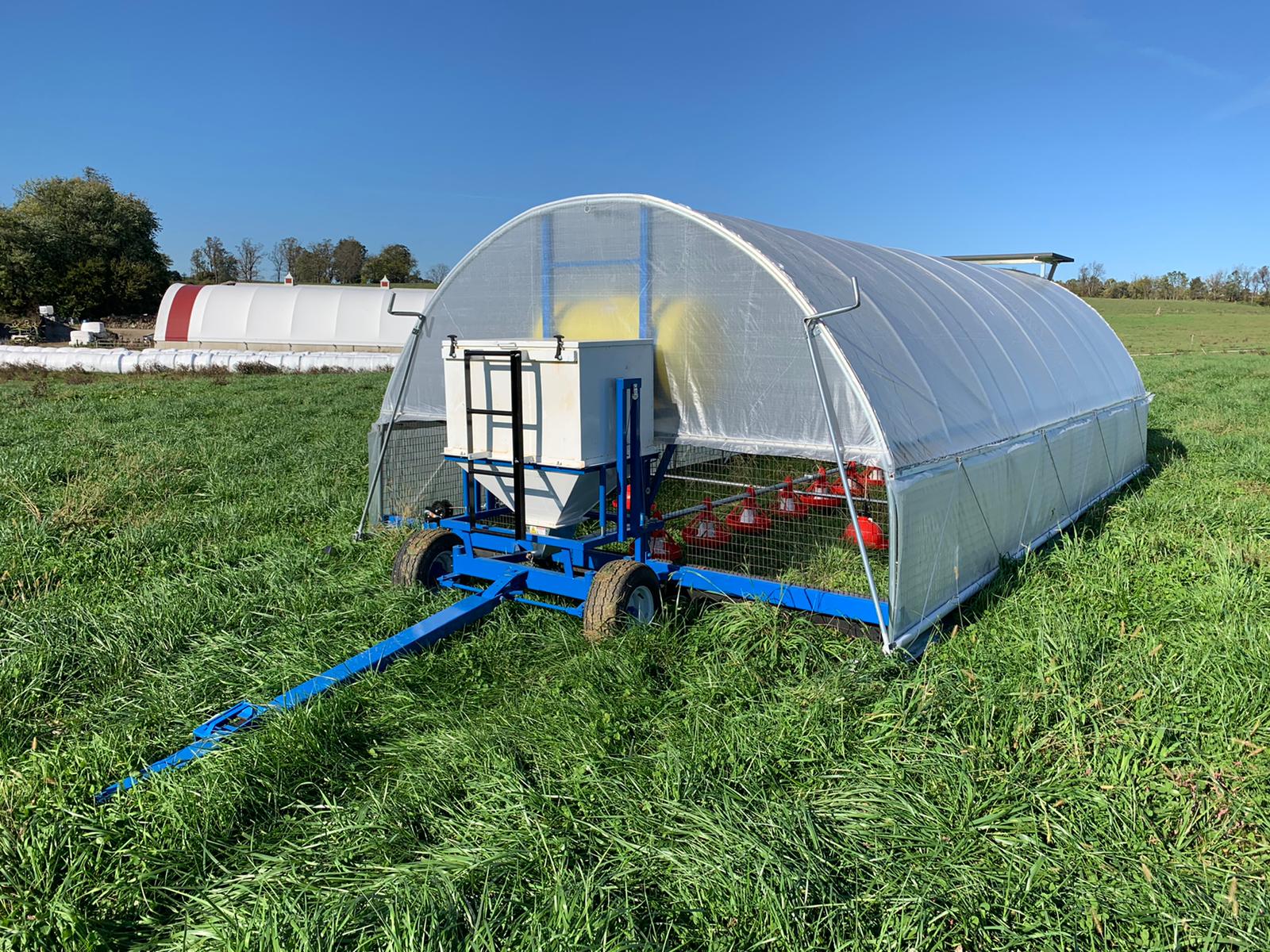
For a broiler coop to be mobile, it has to have a hitch hook-up.
Traditionally, mobile chicken houses were pulled like a trailer when they were moved.
While this works pretty well, there is one small problem: when pulling the coops, you can’t see behind you very well. On occasion, a chicken will get in front of the moving coops and be run over. Oops!
The hitches on our new broiler houses allow for the traditional pulling, as well as an option for pushing the coop.
This allows you to clearly see what is happening in front of you and encourages the birds to move ahead of the tractor instead of behind it.
Feature #7
Rubber Flaps To Protect Chickens
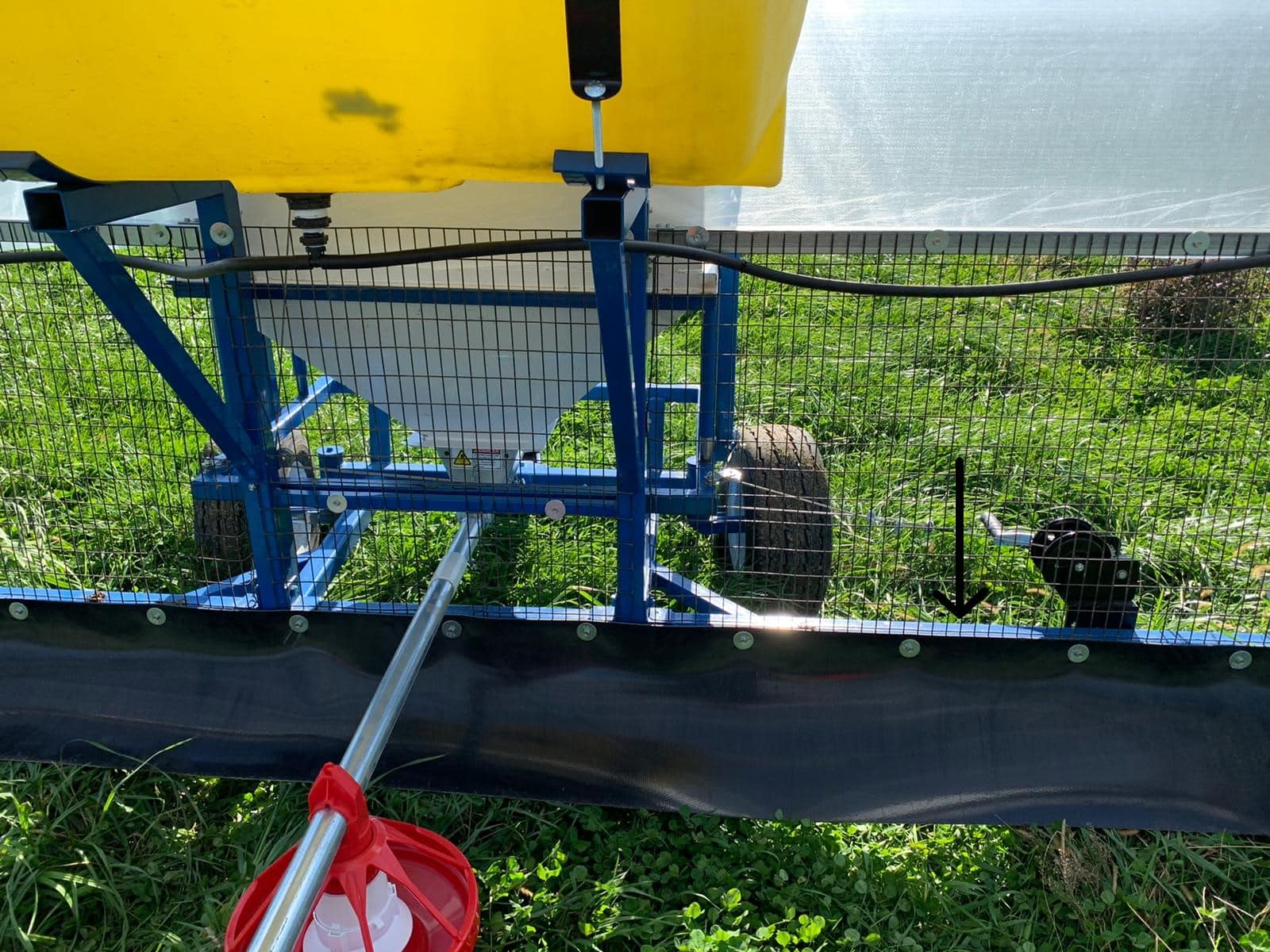
A hitch that allows you to push a mobile chicken house instead of pulling it is a good start in protecting the chickens while houses are in transit.
However, a backup plan is always a good idea!
That’s why we’ve installed rubber flaps at the base of our broiler houses.
If a chicken does happen to get run over, the rubber flap allows the coop to ride over the bird and not harm them - which is highly preferable to an injured or dead chicken!
Feature #8
Heavy Duty Tarp Covering

Protecting your birds is vital in running a successful chicken farm. After all, if the chickens are injured or die, you’ll end up losing a lot of money.
Many people consider metal to be the best material for covering a chicken house, but we prefer heavy-duty tarps for several reasons.
First of all, metal is much heavier than tarps. Keeping a chicken hoop relatively lightweight is critical, especially if you plan on moving it regularly.
Beyond that, metal shrinks and expands with changing weather, which can affect the structure of your chicken house.
If that’s not enough, every misplaced metal screw presents a hazardous sharp edge - both to chickens and humans!
So, while they are a bit unconventional, heavy-duty tarps prove to be more efficient, safe, and effective than metal.
Feature #9
Adjustable Curtain Sides
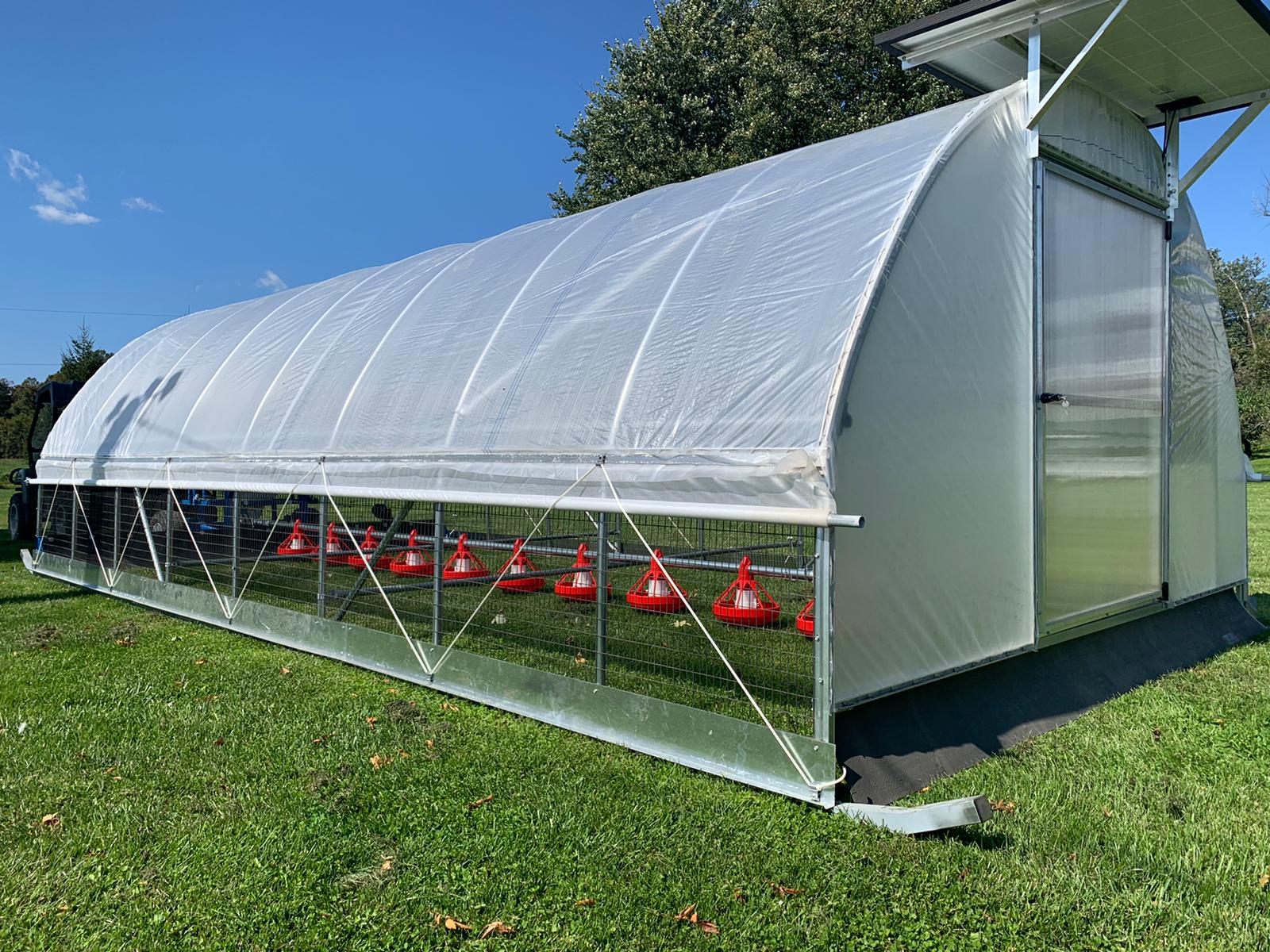
Another perk of heavy-duty tarps is that they allow the sides of the chicken house to be rolled up and adjusted to your preference.
This is particularly helpful on hot summer days when extra air movement is critical to a chicken’s well-being.
Feature #10
Water Tank and Water Bells
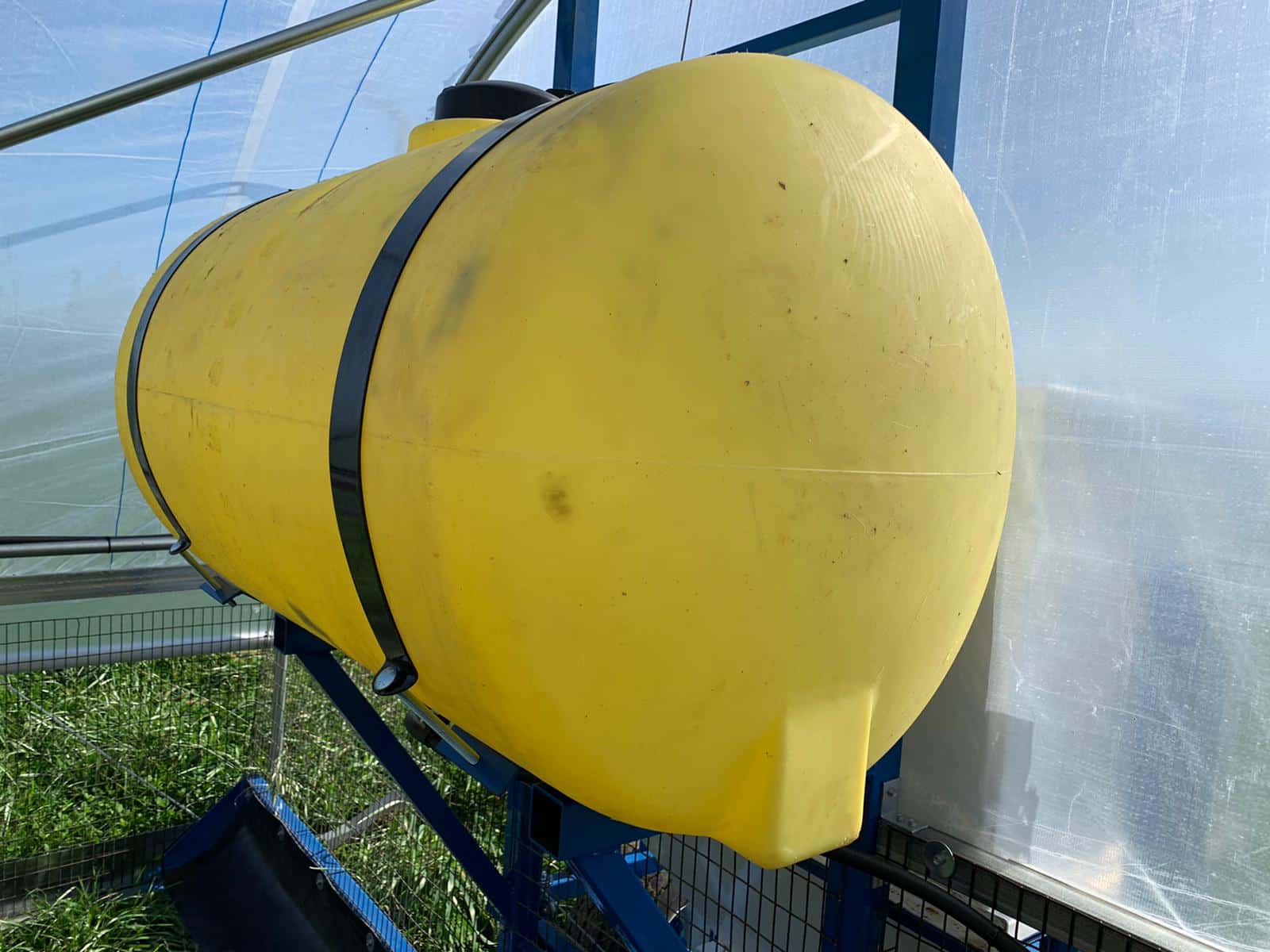
Just like feed, chickens need water every day. That’s why having a water holding tank directly on the mobile chicken coop is so important.
To be clear, it is essential that chickens have good, clean water to drink - it’s critical to their health! (Read “How To Keep Your Chickens Healthy” to get all the information on keeping your flock in tip-top shape).
However, you can save yourself a lot of time by having a simple water tank installed on your broiler coop.
Our water stations are automated to empty into adjustable water bells. These adjustable water bells make sure your birds always have ample water!
Feature #11
Solar Setup
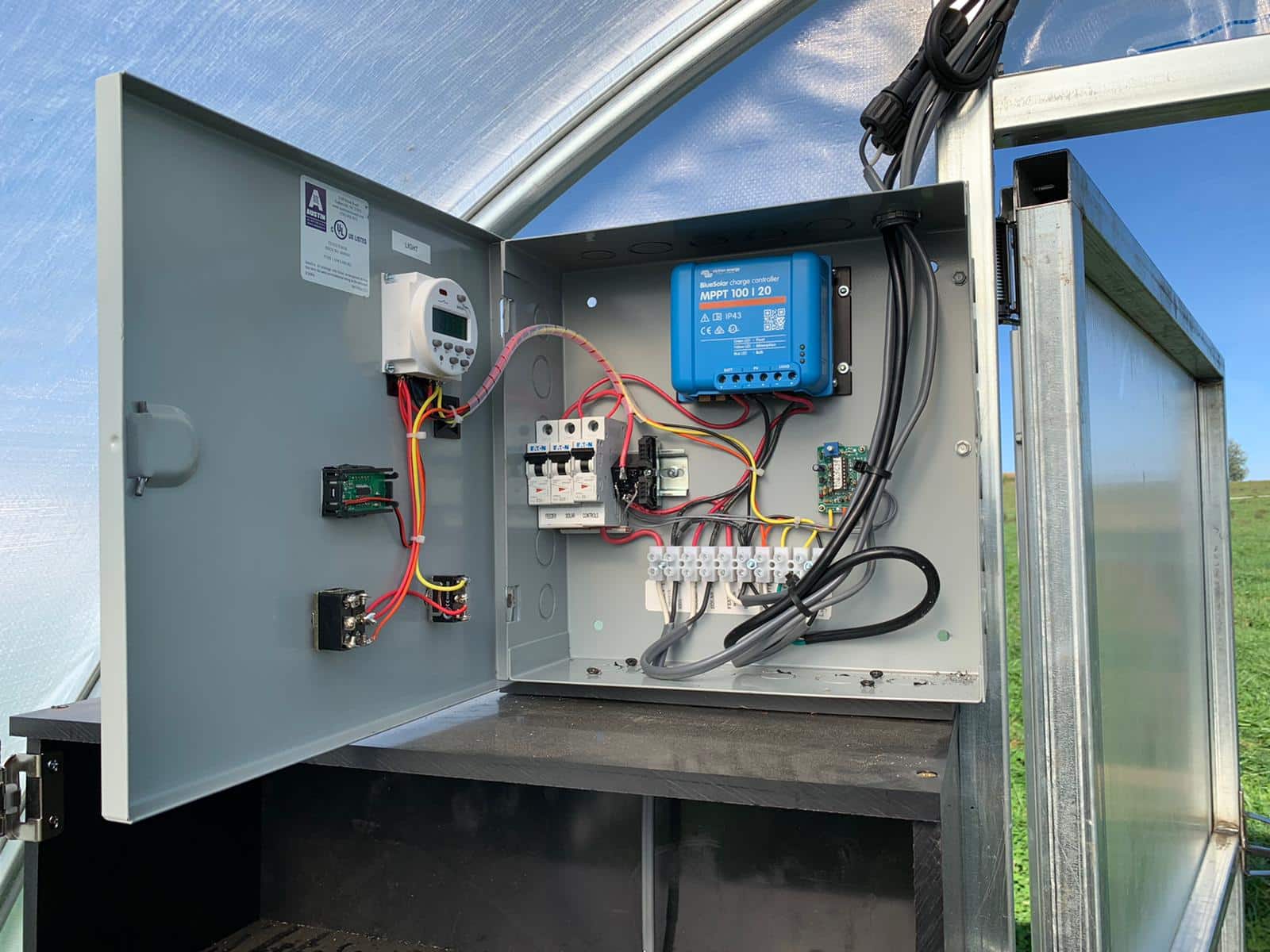
You may be wondering how the automated features of our mobile range coops operate - especially if you move them regularly!
The solution is a solar setup - so you can benefit from all the features of the coops all the time, and save on electricity costs.
It’s a win-win!
Conclusion
You don’t have to be trapped and frustrated as a chicken farmer. You can run a quality-driven and sustainable farm while remaining profitable.
When you achieve those standards, you have a clear conscience and can comfortably provide for yourself and your family.
If you are interested in raising broilers in a mobile chicken house, let The Mobile Chicken House team know. We would love to help you get started!
We offer mobile coops for broilers as well as multiple models of mobile chicken houses for egg layers.
We also offer chicken house financing, and if you want to explore the soundness of your investment, check out our profit calculator.
Contact us today. We look forward to hearing from you!

